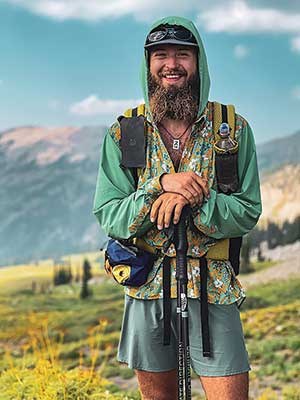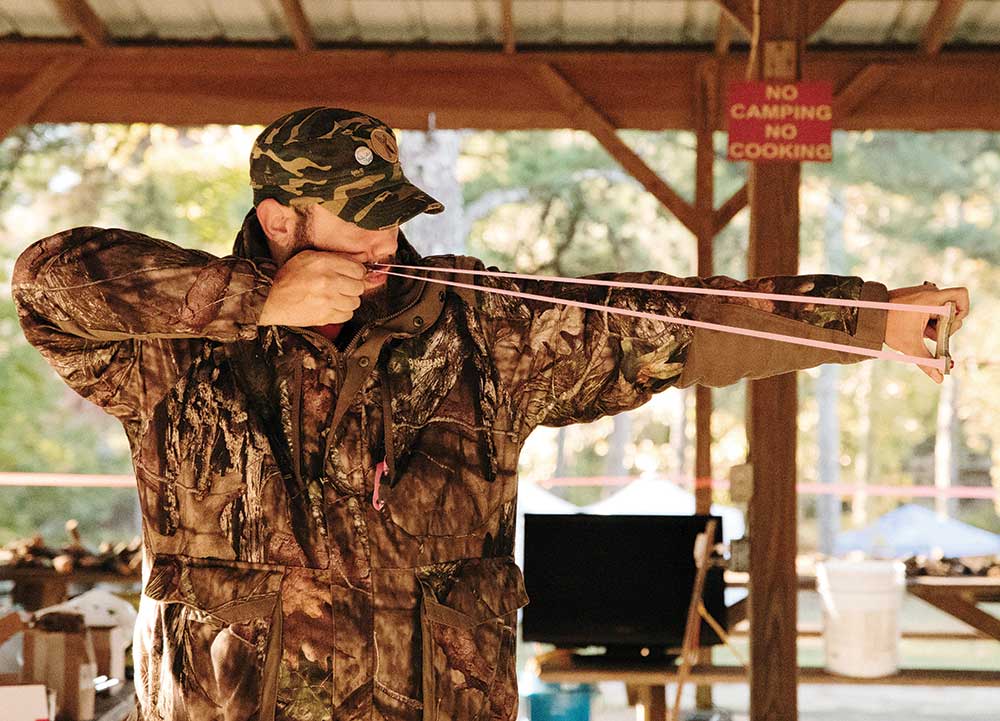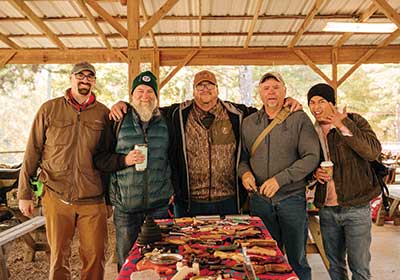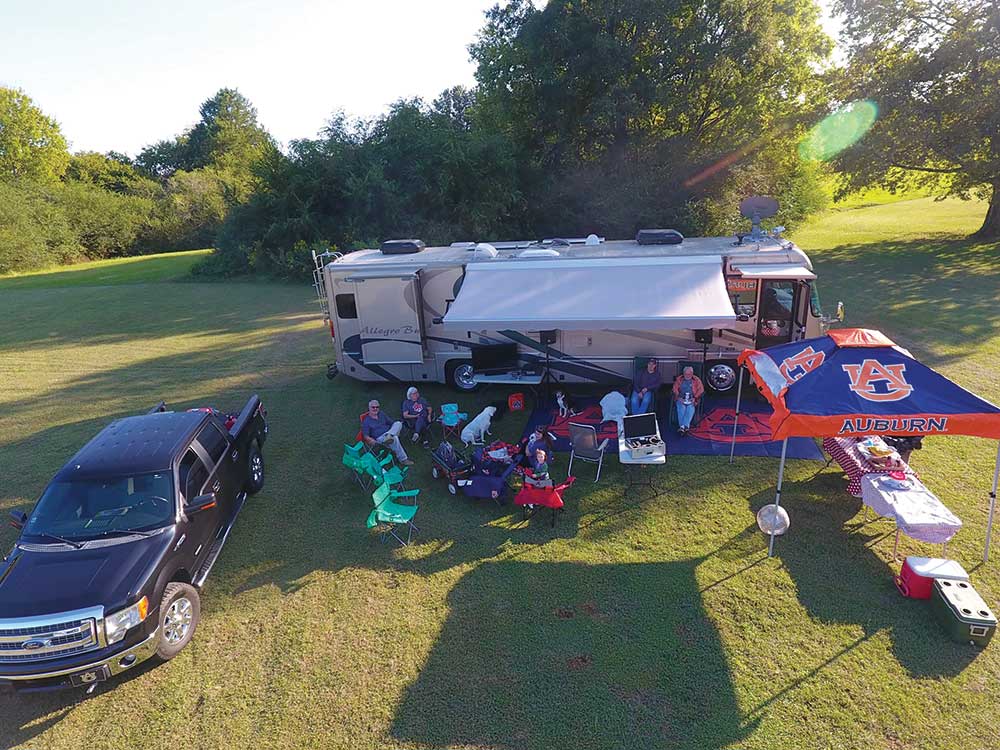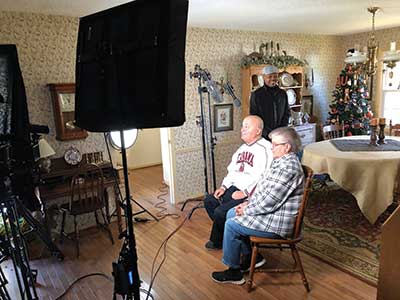Pell City native discovers his future along hiking trail
Story by Scottie Vickery
Photos courtesy of Bennett Fisher
When Bennett Fisher agreed to hike the Appalachian Trail with his father after his high school graduation, he thought the trip would buy him some time before making major life decisions. But somewhere along the 2,189-mile trek he took to avoid thinking about his future, the Pell City native discovered it instead.
“I didn’t know where I wanted to go to college or what I wanted to do, and I figured it would allow me to put the decision off a bit,” said Bennett, a 2015 Pell City High School graduate. “But while we were backpacking, the people we met were really cool, the gear was really cool, and I started thinking it would be fun to be a designer.”
Seven years later, Bennett’s dream, which started taking shape on that trail, is a reality. Last October, he launched his online company, Jolly Gear (jollygearapparel.com), which offers the hybrid sun shirt he designed to meet a hiker’s every need.
It’s fast drying, offers sun and odor protection, and unlike most outdoor shirts available, it’s a vibrant, colorful creation that looks great in photos. He named the shirt the Triple Crown Button Down Sun Hoodie, a nod to the Triple Crown of Hiking: conquering the Appalachian Trail, the Pacific Crest Trail and the Continental Divide.
“It’s where fun meets functional,” said Bennett, quoting the tagline on the Jolly Gear logo. “I really enjoy the outdoors, and I like to problem-solve. I wanted to design something and make it different, better and special. People are buying them, and I’m just overjoyed.”
The first steps
The summer before Bennett’s senior year of high school, he was at the beach with his parents, Henry and Vicki Fisher, when they saw a father teaching his son to catch a wave. “I was joking around and said, ‘I wish my parents were cool enough to teach me to surf,’” he recalled. “My father said, ‘Well, if you want a cool dad, why don’t we hike the Appalachian Trail next summer?’”
Bennett agreed, and a few months later he posted about it on Instagram. “My dad texted me and said, ‘Oh, you’re serious. I guess we’re doing this,’” he said. “We’d never backpacked before. I grew up camping, and we’d take day hikes, but we’d never loaded up a backpack with four days of food and set out with no vehicle or anything. I knew nothing.”
His father researched gear and got what they needed, but Bennett didn’t give the trip a lot of thought in advance. “The day we left was the first time I’d fully loaded my pack,” he said. “My friends asked all these ‘what if’ questions – what if you get hurt, what if the weather is bad – but my plan was that I was just going to walk.”
The trek, which stretches from Georgia to Maine, took 5 ½ months, and Bennett was a different person when they finished in December. “I had some of the most real conversations I’d ever had with my dad,” he said. “He told me that he wanted to prove to himself that he could still do something that was epic.”
Bennett didn’t know it then, but each step he took brought him closer to his own epic adventure: designing a product, launching a brand and becoming a business owner at 24. “Right now, this is a side hustle, but I can see it becoming something much bigger,” he said.
The winding trail
Bennett, now 25, has always loved the outdoors, but he was surprised at how many other people seemed to, as well. Hikers were everywhere on the Appalachian Trail, and “I thought, ‘There are jobs here; people are doing this,’” he said, adding that the hiking community has grown tremendously since 2015.
He came home, enrolled at Jefferson State Community College and graduated in the spring of 2017. During his last semester, he began preparing to hike the Pacific Crest Trail with a friend while also researching options for the next phase of his education.
He stumbled across Utah State, which offered a major in outdoor product design and development. “I couldn’t believe it,” he said. “I’d had the idea to work for a brand like Osprey or Patagonia, and I thought I could get a degree in this and work for a company like that. Plus, I’d always wanted to go to Utah. It seemed like kind of a mystical place to me.”
To make it work, Bennett needed to save some money. He decided to take a gap year and enroll in the fall of 2018. In the meantime, he and a buddy set off to conquer the 2,650 miles of the Pacific Crest Trail, which starts at the Mexican border in southern California and winds through Oregon and Washington before ending at the Canadian border.
It was a lofty goal, and Bennett made it halfway before breaking his ankle. Although he was disappointed, he wasn’t giving up on his hiking goals or the dreams for his future. He found jobs at an outdoor apparel store and an indoor climbing facility, put some money aside and learned he’d earned a scholarship that made his Utah adventure possible.
“Before school started, I finally did the whole Pacific Crest Trail that summer,” Bennett said. In addition to marking the hike off his bucket list, he got the inspiration for the Triple Crown Button Down he would eventually design.
“You become pretty close to people pretty fast when you’re backpacking because you spend so much time together,” Bennett said. “You meet folks out there, and they become your trail family – the people you camp with, eat with, hike with.”
One hiker he met was a guy named Max. “He was wearing his mother’s gardening shirt, which had a hood, long sleeves, and buttons,” Bennett recalled. “At the time, everyone had to choose between a sun hoodie, which didn’t have buttons (allowing you to open the shirt to catch a breeze), or a fishing shirt. The rest of the trail, I kept thinking that I wanted to design something like that.”
Triple Crown design
The thought made him even more excited about school, but once in Utah, he grew discouraged. “All these people had been in art classes growing up, and they were all light-years ahead of me,” he said. Being several years older than his classmates didn’t help either, and “it was pretty intimidating to be around such talented folks.”
Despite his doubts, Bennett continued to do what he’s always done: he just kept going. Two sewing classes were required for his major, and that’s when everything started falling into place. In the first class, he had to make either a jacket or a shirt, and his Triple Crown Button Down first came to life. “It took me 72 hours to hand-sew that first prototype,” he said.
The shirt was a combination of a Performance Fishing Gear shirt and a sun hoodie. Thumb holes in the sleeves offered sun protection for the hands while the hood protected the neck. Two zipper pockets on the chest are perfect for holding a phone or wallet.
“I combined a button down and sun hoodie into one; there’s no more compromise,” Bennett said. “At that point, I thought I had just made the shirt for myself, and I was pretty proud of it.” His confidence grew when he earned a perfect score, and the shirt was named runner-up in a vote by his classmates.
His final semester, he took a class on logo design and branding. “We had to create a fake company and a fake clothing line,” he said. The logo he designed was an outline of a man’s face with a long beard, which is actually an image of a pine cone. He landed on Jolly Gear for the name, in honor of the nickname he got on the Appalachian Trail.
“They called me Jolly because I was very positive and optimistic,” he said, adding that long-distance hikers go by nicknames. “Most of the time, people give you the name. My dad was Powerslide because he slipped on the rocks a lot but still managed not to fall.”

Launching a dream
At the time, Bennett thought he was just completing a class project, but graduating in May 2020 in the middle of a pandemic made him rethink things. “I graduated when no one was hiring, and everyone was getting laid off,” he said. “All of these outdoor companies were letting people go. How was I, a guy with no experience, going to get a job over people who had been doing this for 10 years?”
He found a job as a software tester and decided to launch Jolly Gear on the side. He offers hats and T-shirts, as well, but the star is the Triple Crown Button Down, which features all of Bennett’s must-haves. The four-way stretch fabric is extremely lightweight, odor-resistant and offers UPF-50 sun protection.
In addition to thumb holes, there’s a hair hole and cinch cord in the hood, and most importantly, it’s bright and colorful. “I wanted to have fun patterns” so it would stand out from the typical solid khaki, gray, light blue or yellow options. Long-distance hikers typically wear one shirt for weeks or months at a time, and “I wanted to create something you’d be proud to show in every single picture on the trail,” he said.
In an effort to earn his own Triple Crown, Bennett was hiking the Continental Divide, which spans some 3,100 miles through New Mexico, Colorado, Wyoming, Idaho and Montana, when the first samples were finished last summer. He had some shipped to himself, and he and a few members of his trail family picked them up together. “We literally ripped our shirts off in the post office and tried them on,” he said.
“I had never seen the print in person, and the size of the flowers was exactly what I had imagined,” he said. “Eight of us wore them on the trail and out to dinner. They got a lot of attention, and everybody loved them. People have told me it’s the fastest-drying shirt they’ve ever had.”
While Bennett hoped to earn his Triple Crown while wearing his Triple Crown Button Down, he fractured his left foot 1,650 miles into the trip. He plans to pick up the trail where he left off and finish the hike this summer, but he’s thrilled that one of his seven friends who wore the shirt finished and earned his Triple Crown in style.
Despite having been worn for thousands of sweaty miles, the shirt “still looks beautiful,” Bennett said. “He actually wore it on a date a few days later. I was so excited – it’s everything I hoped for and more.”















